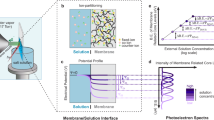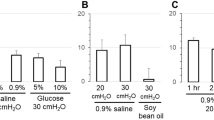Abstract
THE major portion of renal salt and water reabsorption occurs within the proximal convoluted tubule, amounting in mammalian kidneys to about 80 per cent of the quantities present in the glomerular nitrate. Based on indirect evidence, proximal sodium transport has been postulated to be active. Recently, however, results obtained in stop-flow experiments were interpreted in such a way as to indicate passive bulk movement of tubular fluid as the predominant mode of proximal tubular salt transfer. Micropuncture work on rats has demonstrated unequivocally the existence of active sodium transport across proximal epithelium1, but did not provide information as to the relative contribution of active sodium transport to the overall net movement of this ion species. The present work represents an attempt to clarify this point by correlating active transport of ions as measured by the short-circuit method with measurements of net movement of water under comparable conditions. Assuming that proximal fluid reabsorption is isosmotic—an assumption in agreement with all known measurements of osmotic pressure of proximal tubular fluid—net water movement can be used as an index of net transport of sodium. Thus short-circuit current can be correlated with net movement of sodium.
This is a preview of subscription content, access via your institution
Access options
Subscribe to this journal
Receive 51 print issues and online access
$199.00 per year
only $3.90 per issue
Buy this article
- Purchase on Springer Link
- Instant access to full article PDF
Prices may be subject to local taxes which are calculated during checkout
Similar content being viewed by others
References
Windhager, E. E., and Giebisch, G., Amer. J. Physiol., 200, 581 (1961).
Ussing, H. H., and Zerahn, K., Acta physiol. Scand., 223, 110 (1951).
Coombs, J. S., Eccles, J. C., and Fatt, P., J. Physiol. (Lond.) 130, 291 (1955).
Karger, W., Eigler, F. W., and Hampel, A., Pfluegers Arch. ges. Physiol., 272, 187 (1960).
Hodgkin, A. L., and Rushton, W. A. H., Proc. Roy. Soc., B, 133, 444 (1946).
Windhager, E. E., Whittembury, G., Oken, D. E., Schatzmann, H. J., and Solomon, A. K., Amer. J. Physiol., 197, 313 (1959).
Author information
Authors and Affiliations
Rights and permissions
About this article
Cite this article
WINDHAGER, E., GIEBISCH, G. Comparison of Short-Circuit Current and Net Water Movement in Single Perfused Proximal Tubules of Rat Kidneys. Nature 191, 1205–1207 (1961). https://doi.org/10.1038/1911205a0
Issue Date:
DOI: https://doi.org/10.1038/1911205a0
This article is cited by
-
Electrophysiology of Triturus nephron: Cable properties and electrogenic transport systems
Kidney International (1990)
-
Influence of lateral intercellular spaces on current propagation in tubular epithelia as estimated by a multi-cable model
Pfl�gers Archiv European Journal of Physiology (1988)
-
Short term effect of low doses of tri-iodothyronine on proximal tubular membrane Na−K-ATPase and potassium permeability in thyroidectomized rats
Pflügers Archiv (1985)
-
Regulation of volume reabsorption by thyroid hormones in the proximal tubule of rat: Minor role of luminal sodium permeability
Pflügers Archiv (1985)
-
Miniature Ag−AgCl electrode for voltage clamping of theAmbystoma collecting duct
The Journal of Membrane Biology (1982)
Comments
By submitting a comment you agree to abide by our Terms and Community Guidelines. If you find something abusive or that does not comply with our terms or guidelines please flag it as inappropriate.



